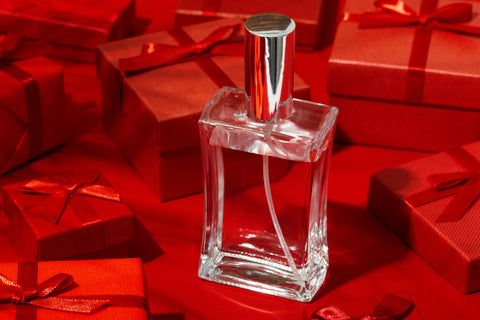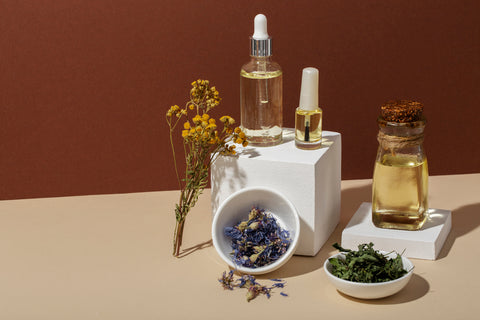Fragrances have played a captivating role in human history for millennia, transcending mere scents and weaving themselves into the fabric of cultures and personal expression. From the aromatic resins and oils used in ancient Egypt to the complex concoctions of modern perfumery, fragrances have served a multitude of purposes. They have been employed in religious ceremonies, social rituals, and as a form of personal adornment.
In today's world, fragrances remain a vital part of personal care routines. They offer a powerful tool to enhance one's mood, boost confidence, and leave a lasting impression. However, navigating the world of fragrances can be confusing, especially when it comes to the terminology used to describe different types. Terms like "perfume" and "toilette" are often used interchangeably, leading to misconceptions about their properties and appropriate use.
This blog aims to shed light on the key distinctions between perfume and toilette, specifically focusing on Eau de Toilette (EDT) as the most common interpretation of "toilette" in the fragrance world. We will delve into the core difference – fragrance concentration – and explore how it impacts the strength, longevity, and sillage (scent trail) of each type. Additionally, we will provide guidance on selecting the perfect fragrance for different occasions and skin types, empowering you to make informed choices and discover your signature scent.

Demystifying the Terminology
The French Connection
The language of fragrance is steeped in French history. The very word "perfume" has French roots, deriving from the Latin "per fumum," which translates to "through smoke." This likely references the ancient practice of burning fragrant materials to create scented smoke for religious ceremonies or to mask unpleasant odors.
The term "Eau de Toilette" (EDT) also hails from France. Literally translated, it means "water of the toilet." However, the interpretation of "toilette" in this context differs from its modern meaning. In 16th century France, "faire sa toilette" referred to the entire process of getting ready, encompassing bathing, grooming, and applying cosmetics. Eau de Toilette, therefore, was a fragrant water used during this process, not just for cleaning but also for refreshing and scenting the body.
Eau de Toilette (EDT)
As mentioned earlier, Eau de Toilette (EDT) sits on the fragrance spectrum with a lower concentration of perfume oil compared to Perfume (Parfum). This perfume oil concentration typically falls within the range of 8% to 12%. The lower concentration translates to a lighter and more subtle scent experience compared to its more potent counterparts. This characteristic makes EDT a popular choice for everyday wear, particularly in situations where a strong fragrance might be overpowering.
It's important to note that within the category of Eau de Toilette, there can be some variation in the exact perfume oil concentration depending on the brand and specific fragrance. However, most reputable fragrance houses will clearly indicate the type of fragrance (EDT, EDP, etc.) on the product packaging, making it easier for consumers to understand the strength and longevity they can expect.
Perfume (Parfum)
On the other end of the fragrance spectrum lies Perfume (Parfum), boasting the highest concentration of perfume oil. This concentration typically starts at 20% or higher, sometimes reaching as high as 40%. The result is a luxurious, full-bodied scent with exceptional intensity and longevity. Perfumes are designed to make a statement, leaving a lasting impression with their potent fragrance.
Due to the higher concentration of perfume oil, perfumes tend to be more expensive than Eau de Toilette. Additionally, the higher alcohol content in some perfumes may not be suitable for all skin types, particularly those prone to sensitivity.

Concentration is Key: The Core Distinction
The Power of Perfume Oil
The heart of the distinction between perfume and toilette lies in the concentration of perfume oil. Perfume oil, also known as essence or fragrance oil, is the magic ingredient that carries the aromatic compounds responsible for a fragrance's scent. The higher the concentration of perfume oil in a fragrance, the stronger and longer-lasting it will be.
Fragrance oil is a complex blend of various aromatic molecules derived from natural sources like essential oils and flowers or synthetic aroma chemicals. These molecules interact with our olfactory receptors, triggering the sense of smell. The perception of scent also involves the concept of fragrance notes. A fragrance is typically composed of three layers of notes that unfold over time, creating a scent experience with depth and complexity.
- Top Notes: The most volatile and fleeting notes, typically citrusy, fruity, or herbal, providing the initial impression of the fragrance.
- Middle Notes: Emerging after the top notes fade, these heart notes often represent the core character of the fragrance, with floral, spicy, or oriental scents.
- Base Notes: The most persistent notes, anchoring the fragrance and providing depth and longevity. Base notes are typically heavier scents like musks, woods, or amber.
Unveiling the Layers: Concentration and Fragrance Notes
-
Perfume (Parfum): Reigning supreme in the fragrance world, Perfume boasts the highest concentration of perfume oil, typically ranging from 20% or higher and sometimes reaching as high as 40%. This translates to a powerful and long-lasting scent experience. A spritz of perfume can linger for a glorious 6-8 hours, allowing the full fragrance story to unfold with all its layers of top, middle, and base notes. The richness of perfume oil also allows for a more complex and nuanced fragrance composition.
-
Eau de Parfum (EDP): With a concentration of perfume oil between 15-20%, Eau de Parfum offers a strong and long-lasting fragrance experience. EDPs typically last for 4-5 hours, making them a versatile choice for a variety of occasions. While some EDPs deliver the full spectrum of fragrance notes, the lower concentration compared to Perfume might cause the lighter top notes to dissipate slightly faster.
- Eau de Toilette (EDT): Occupying the middle ground, Eau de Toilette contains a moderate concentration of perfume oil, ranging from 8% to 12%. This results in a lighter and more subtle scent experience compared to Perfume and EDP. EDTs typically last for 2-3 hours, making them ideal for everyday wear or situations where a stronger fragrance might be overpowering. The lighter concentration allows the top notes to be more prominent, offering a refreshing and initial burst of fragrance.
Beyond Concentration: Other Factors
It's important to remember that fragrance longevity can be influenced by factors beyond just concentration. Skin type plays a role, with drier skin tending to hold onto fragrance for a shorter time compared to oilier skin. Climate can also affect fragrance performance. Hot and humid environments can cause fragrance to evaporate faster, while cooler temperatures allow the scent to linger for a longer duration. Being mindful of these factors can help you choose the right fragrance and maximize its effectiveness.

Choosing Your Weapon: When to Use Each
Strength Matters: Considering the Occasion
Selecting the right fragrance hinges on understanding the interplay between concentration and occasion. Here's a breakdown to guide your choices:
- Perfume (Parfum): Reserve this potent elixir for special evenings or momentous occasions. Perfume's strength and longevity ensure your fragrance makes a lasting impression. Think of a glamorous night out, a wedding, or a formal event where you want to exude an air of sophistication and confidence.
- Eau de Parfum (EDP): This versatile fragrance offers a sweet spot between strength and wearability. EDP is a great choice for everyday wear, especially in cooler weather where the scent can bloom. It's also suitable for work environments or social gatherings where you want a noticeable yet not overpowering presence.
- Eau de Toilette (EDT): Embrace the lightness of EDT for daytime wear, casual outings, or situations where a subtler fragrance is preferred. The refreshing nature of EDT makes it ideal for warmer weather or crowded spaces where a strong fragrance might be intrusive. Consider EDT for running errands, attending daytime events, or simply adding a touch of fragrance for personal enjoyment.
Remember, these are just general guidelines. Ultimately, the best way to choose is to experiment and find what works for you. However, being mindful of the occasion and the strength of the fragrance ensures you leave a positive olfactory impression.
Sensitivity Matters: Considering Your Skin
For those with sensitive skin, fragrance selection becomes even more crucial. The higher alcohol content in some Eau de Toilette and Eau de Parfum formulations can cause irritation. Perfume, with a lower alcohol content and a higher concentration of perfume oils, might be a gentler option for sensitive skin. Always perform a patch test on your inner arm before applying any fragrance to a larger area.
Sillage Matters: Leaving Your Mark
Sillage, a French term for "wake," refers to the trail of fragrance a person leaves behind as they move. The concentration of perfume oil directly influences sillage. Perfume boasts the strongest sillage, leaving a noticeable and lingering scent trail. Eau de Parfum follows with a moderate sillage, while Eau de Toilette has the lightest sillage, creating a more intimate olfactory experience.
While a captivating fragrance can be an extension of your personality, it's important to be mindful of personal space. A strong sillage can be overwhelming for others, particularly in close quarters. Opt for lighter fragrances or a more moderate application in enclosed spaces or crowded environments. Remember, a subtle hint of fragrance is often more alluring than an overpowering cloud of scent.

Beyond the Basics: Exploring Other Fragrance Types
Eau de Cologne (EDC)
Eau de Cologne (EDC) occupies a unique space in the fragrance world, boasting the lowest concentration of perfume oil amongst commonly encountered options. Typically, the concentration falls within the range of 2-4%. This translates to a very light and refreshing scent experience, perfect for those seeking a subtle hint of fragrance or for situations demanding a particularly understated approach.
Historically, Eau de Cologne holds a significant place. Originating in 17th century Cologne, Germany, it was initially used for medicinal purposes. Over time, its refreshing and invigorating nature transitioned it into the realm of personal fragrance. Traditional Eau de Cologne fragrances are known for their citrus-dominant scents, often featuring notes of lemon, bergamot, and orange combined with aromatic herbs like rosemary or lavender. The lighter concentration and emphasis on citrus notes make Eau de Cologne an ideal choice for hot weather or active lifestyles.
Eau Fraiche
For those seeking an even more ephemeral fragrance experience, Eau Fraiche offers a delightful solution. This category features an incredibly low concentration of perfume oil, typically ranging from 1-3%. The result is a whisper-light scent that is invigorating and fleeting. Think of Eau Fraiche as a refreshing splash on a warm summer day, offering a temporary delight without the commitment of a longer-lasting fragrance.
The composition of Eau Fraiche often leans towards citrus and aquatic notes, evoking feelings of cleanliness and freshness. Cucumber, melon, and marine accords are frequently found in these fragrances, creating a light and airy scent experience. Due to their short-lasting nature, Eau Fraiche fragrances can be reapplied throughout the day for a continuous touch of cool refreshment. They are particularly well-suited for layering with other fragrances, adding a subtle base layer without overpowering the main scent.
Conclusion
Our exploration has shed light on the fundamental distinction between Perfume and Eau de Toilette: concentration. Perfume, boasting the highest concentration of perfume oil, delivers the strongest and most long-lasting scent experience. Eau de Toilette, on the other hand, offers a lighter and more subtle fragrance journey due to its lower concentration. This difference translates to variations in intensity and longevity, allowing you to choose the perfect fragrance based on the occasion.
Remember, selecting a fragrance is a personal journey. Consider the occasion, your skin type, and most importantly, your own preferences. Experiment with different concentrations and fragrance families to discover what resonates with you. Embrace the power of fragrance to enhance your mood, boost confidence, and leave a lasting olfactory impression. The world of scents awaits – go forth and find your signature fragrance!

